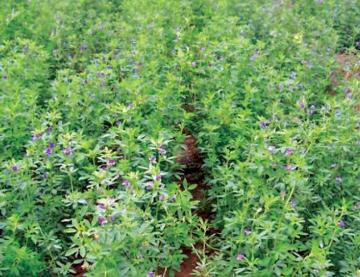Berseem

Berseem (Trifolium alexandrinum)
Local name: Egyptian clover
Berseem is one of the most important fodder crops and has been rightly described as the king of fodders. It is highly esteemed fodder which has a special place in animal husbandry programmes throughout the country. Though a migrant from Egypt, it has established in this region for the last 60 years and may well be considered as a native of India. It has many desirable qualities. Ten to fifteen kg of fodder alone with straw constitutes a maintenance ration. It can support growth and milk production on ad lib feeding, balanced by straws.
It does not tolerate acidic soils but grows in other kinds of soils except usar lands. The crop is sown from middle of September to end of October in plains and from middle of August to first week of September in hills. This crop requires a thorough preparation of land. Berseem is now available in another form called Giant berseem. The advantage of giant berseem is that lesser irrigation is required. While the seed rate of ordinary diploid berseem is 20-25 kg that of giant berseem is 30-35 kg per hectare.
The crop is ready in 55-60 days after sowing for the first cutting. Subsequent cuttings are taken at 30 days interval during winter and spring. In all 5-6 cuttings can be obtained up to middle of May. The total yield obtained may vary between 500-600 quintals/ hectare. For taking the seeds, plots are left uncut after February and in that case 4-5 quintals seeds per hectare may be obtained. Tetraploid berseem has been considered as high yielding variety.
Ordinary diploid and tetraploid or giant berseem are the varieties of the berseem. Amongst the various strains of giant berseem, strain 526 has shown the better result.
Nutritive value
Berseem is highly palatable fodder and it contains 17% crude protein and 25.9% crude fibre. The total digestible nutrients content is 60-65%. Berseem contains saponins, if fed in high quantity to ruminants leads to bloat.
Varieties
Mescawi, Varda, JB-1, 2 and 3, UPB 103, Pusa giant, Khadarvi, Chindwara
No comments:
Post a Comment